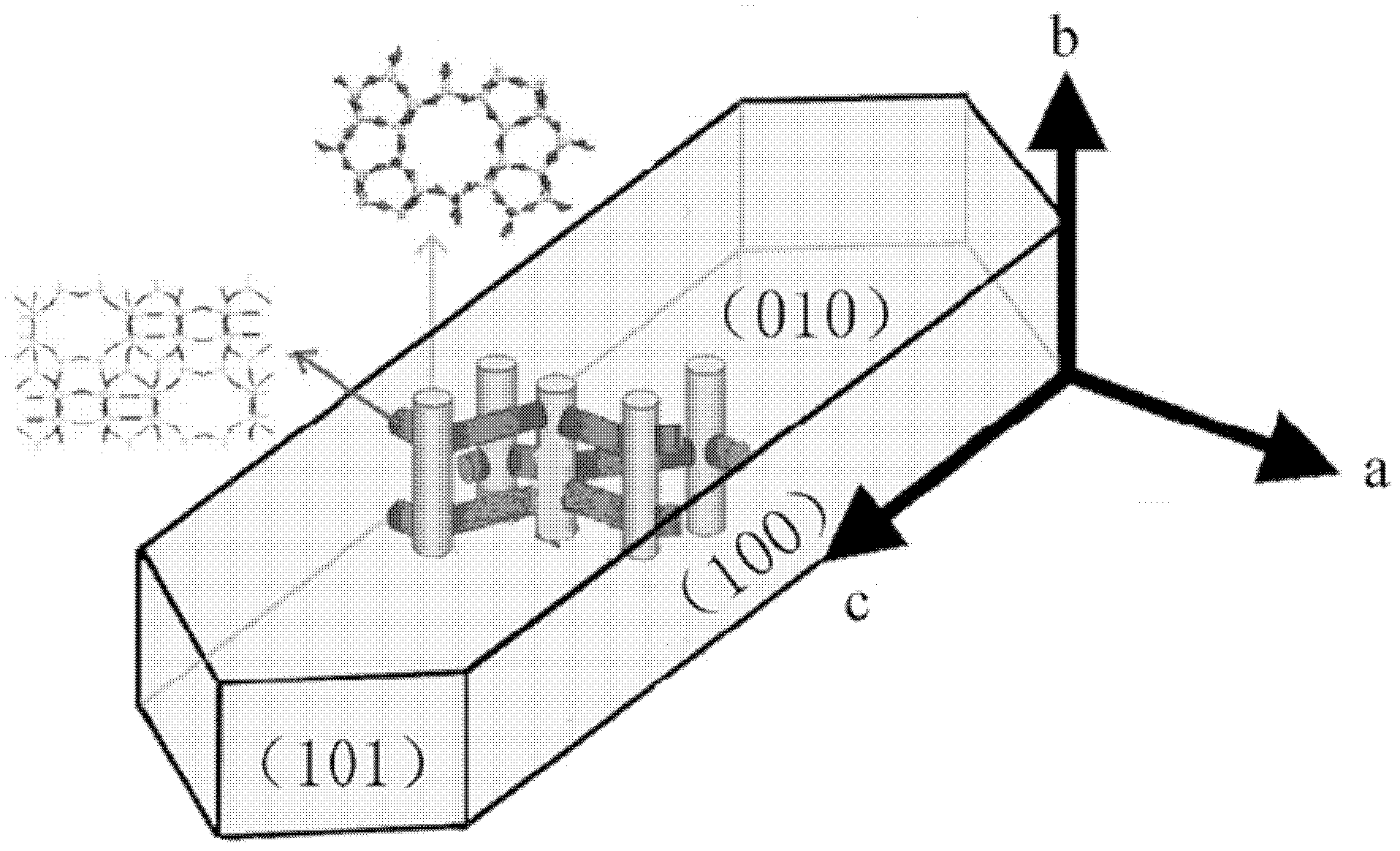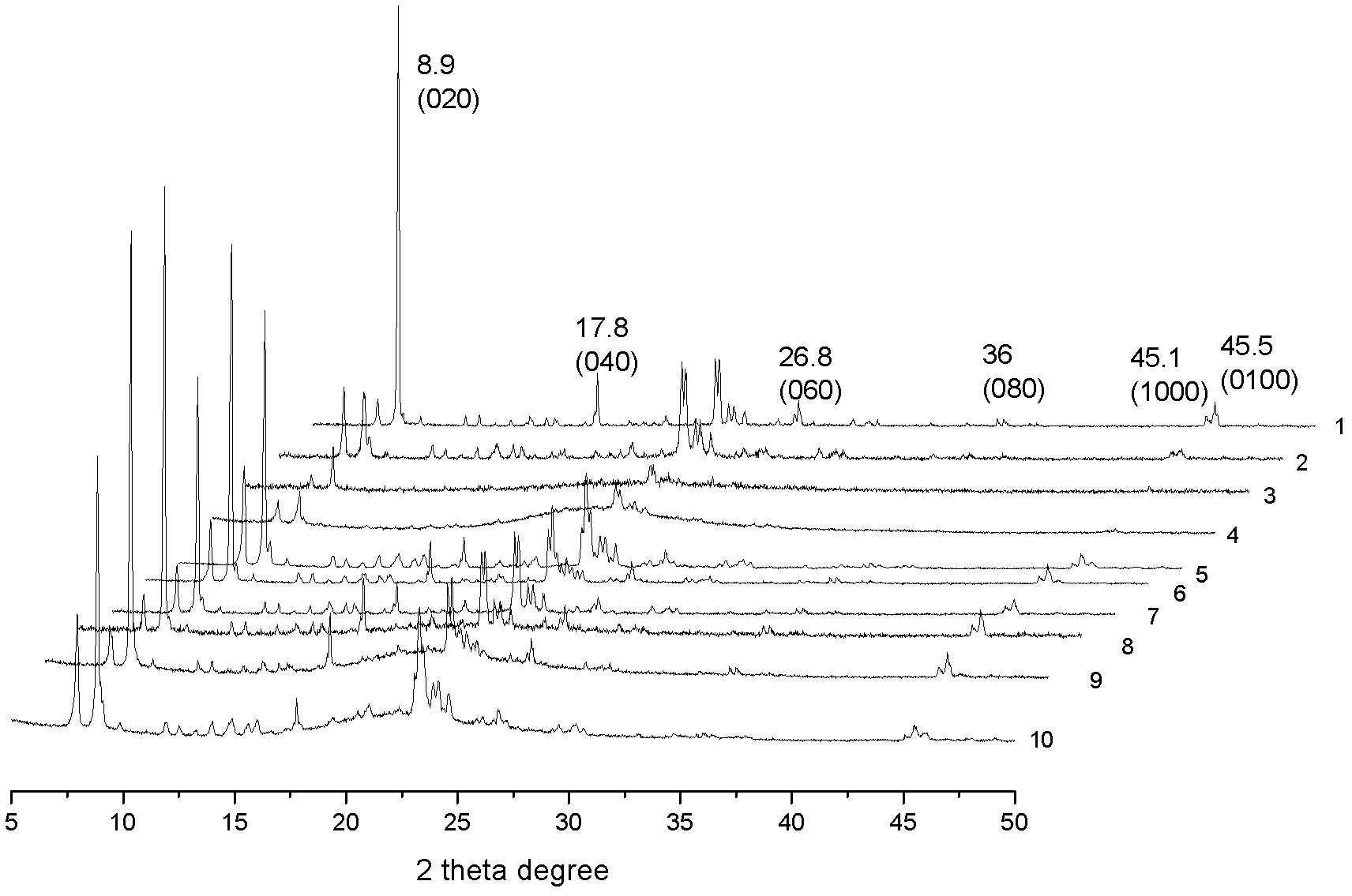Method for preparing 4-hexene-3-ketone by carrying out dehydration on 4-hydroxy-3-hexanone
A technology of hexanone and hydroxyl, applied in the field of dehydration of 4-hydroxy-3-hexanone to prepare 4-hexen-3-one, which can solve the problems of low space velocity, poor catalyst activity and high reaction temperature
- Summary
- Abstract
- Description
- Claims
- Application Information
AI Technical Summary
Problems solved by technology
Method used
Image
Examples
Embodiment 1
[0020] By 1SiO 2 : 0.01Al 2 O 3 : 0.41TEAOH: 0.31 Acetylacetone: 31.76H 2 O Weigh each material, dissolve sodium aluminate in distilled water, add tetraethylammonium hydroxide dropwise, stir for 1 hour, add ethyl orthosilicate dropwise, stir for 1 hour, add acetylacetone, stir for 1 hour , adjust pH=13.0 with 0.1N sodium hydroxide solution, and continue stirring for 5 hours. The obtained mixture was crystallized under hydrothermal conditions at 170° C. for 4 days, washed, filtered and dried. The obtained product had characteristic diffraction peaks of ZSM-5 and preferentially grew in the (010) direction (b-axis). XRD spectrum see figure 2 In curve 1, the relative intensities of (020), (040), (060) and (080) peaks in the diffraction spectrum are significantly increased, which is obviously due to the preferred orientation of ZSM-5 single crystal on the powder diffraction sample plate, its (0h0) The surface, that is, the cylindrical surface of the single crystal, is paralle...
Embodiment 2
[0023] By 1SiO 2 : 0.01Al 2 O 3 : 0.25TPAOH: 0.05 Sodium oxalate: 32.0H 2 O Weigh each material, dissolve sodium aluminate in distilled water, add tetrapropylammonium hydroxide dropwise, stir for 1 hour, add silica sol dropwise, stir for 1 hour, add sodium oxalate, stir for 1 hour, use 0.1 N sodium hydroxide solution was adjusted to pH=12.0 and stirring was continued for an additional 5 hours. The resulting mixture was crystallized under hydrothermal conditions at 200°C for 3 days, washed, filtered and dried. XRD spectrum see figure 2 Middle curve 2. The synthesized ZSM-5 zeolite raw powder was treated with 0.8 mol / L acetic acid at 70° C. for 5 hours for 4 consecutive times, wherein the weight ratio of the acid solution and the ZSM-5 zeolite was 9 to obtain HZSM-5, that is, the catalyst.
[0024] The performance of the catalyst was evaluated according to the steps of [Example 1]. The reaction conditions and reaction results are shown in Table 1.
Embodiment 3
[0026] By 1SiO 2: 0.02Al 2 O 3 : 0.23TEAOH: 0.278-hydroxyquinoline: 44.64H 2 O Weigh each material, dissolve aluminum triethoxide in distilled water, add tetraethylammonium hydroxide dropwise, stir for 1 hour, add silica sol dropwise, stir for 1 hour, add 8-hydroxyquinoline, stir for 1 hour , adjust pH=11.0 with 0.1N sodium hydroxide solution, and continue stirring for 5 hours. The resulting mixture was crystallized under hydrothermal conditions at 150°C for 6 days, washed, filtered and dried. XRD spectrum see figure 2 Middle curve 3. The synthesized ZSM-5 zeolite raw powder was treated with 0.8 mol / L acetic acid at 80° C. for 5 hours for 3 consecutive times, wherein the weight ratio of the acid solution and the ZSM-5 zeolite was 8, to obtain HZSM-5, that is, the catalyst.
[0027] The performance of the catalyst was evaluated according to the steps of [Example 1]. The reaction conditions and reaction results are shown in Table 1.
PUM
 Login to View More
Login to View More Abstract
Description
Claims
Application Information
 Login to View More
Login to View More - R&D
- Intellectual Property
- Life Sciences
- Materials
- Tech Scout
- Unparalleled Data Quality
- Higher Quality Content
- 60% Fewer Hallucinations
Browse by: Latest US Patents, China's latest patents, Technical Efficacy Thesaurus, Application Domain, Technology Topic, Popular Technical Reports.
© 2025 PatSnap. All rights reserved.Legal|Privacy policy|Modern Slavery Act Transparency Statement|Sitemap|About US| Contact US: help@patsnap.com



